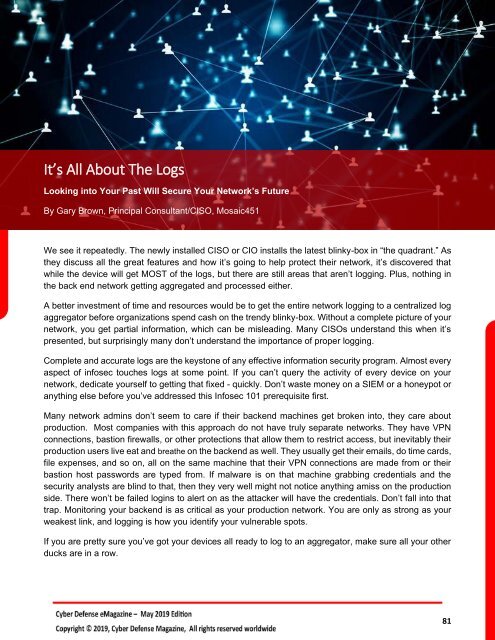Cyber Defense eMagazine May 2019
Cyber Defense eMagazine May Edition for 2019 #CDM #CYBERDEFENSEMAG @CyberDefenseMag by @Miliefsky a world-renowned cybersecurity expert and the Publisher of Cyber Defense Magazine as part of the Cyber Defense Media Group
Cyber Defense eMagazine May Edition for 2019 #CDM #CYBERDEFENSEMAG @CyberDefenseMag by @Miliefsky a world-renowned cybersecurity expert and the Publisher of Cyber Defense Magazine as part of the Cyber Defense Media Group
You also want an ePaper? Increase the reach of your titles
YUMPU automatically turns print PDFs into web optimized ePapers that Google loves.
It’s All About The Logs<br />
Looking into Your Past Will Secure Your Network’s Future<br />
By Gary Brown, Principal Consultant/CISO, Mosaic451<br />
We see it repeatedly. The newly installed CISO or CIO installs the latest blinky-box in “the quadrant.” As<br />
they discuss all the great features and how it’s going to help protect their network, it’s discovered that<br />
while the device will get MOST of the logs, but there are still areas that aren’t logging. Plus, nothing in<br />
the back end network getting aggregated and processed either.<br />
A better investment of time and resources would be to get the entire network logging to a centralized log<br />
aggregator before organizations spend cash on the trendy blinky-box. Without a complete picture of your<br />
network, you get partial information, which can be misleading. Many CISOs understand this when it’s<br />
presented, but surprisingly many don’t understand the importance of proper logging.<br />
Complete and accurate logs are the keystone of any effective information security program. Almost every<br />
aspect of infosec touches logs at some point. If you can’t query the activity of every device on your<br />
network, dedicate yourself to getting that fixed - quickly. Don’t waste money on a SIEM or a honeypot or<br />
anything else before you’ve addressed this Infosec 101 prerequisite first.<br />
Many network admins don’t seem to care if their backend machines get broken into, they care about<br />
production. Most companies with this approach do not have truly separate networks. They have VPN<br />
connections, bastion firewalls, or other protections that allow them to restrict access, but inevitably their<br />
production users live eat and breathe on the backend as well. They usually get their emails, do time cards,<br />
file expenses, and so on, all on the same machine that their VPN connections are made from or their<br />
bastion host passwords are typed from. If malware is on that machine grabbing credentials and the<br />
security analysts are blind to that, then they very well might not notice anything amiss on the production<br />
side. There won’t be failed logins to alert on as the attacker will have the credentials. Don’t fall into that<br />
trap. Monitoring your backend is as critical as your production network. You are only as strong as your<br />
weakest link, and logging is how you identify your vulnerable spots.<br />
If you are pretty sure you’ve got your devices all ready to log to an aggregator, make sure all your other<br />
ducks are in a row.<br />
81


















